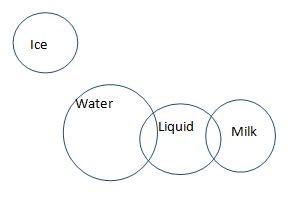Question
Statements: Some water is liquid. Some
liquid is milk. No ice is milk. Conclusions: I. Some water is milk. II. No ice is liquid. III. Some water is ice. In each question below are given some statements followed by some conclusions numbered I, II, etc are given. You have to take the given statements to be true even if they seem to be at variance with commonly known facts and then decide which of the given conclusions logically follows from the given statements, disregarding commonly known facts.Solution
Some water is liquid(I) + Some liquid is milk (I) ⇒ No conclusion. Hence conclusion I and III does not follow. No ice is milk(E) + Some liquid is milk(I) ⇒ conversion ⇒ Some milk is liquid(I) ⇒ Some liquid is not ice(O*). Hence conclusion II does not follow. Minimal possibility: 
In the following question, two statements numbered I and II are given. There may be cause and effect relationship between the two statements. These tw...
Which of the following combination is false?
Statement I: The city municipal corporation has announced a plan to install air purifiers at major traffic intersections across the city.
Stateme...
In the question below, two statements (I) and (II) are given. These statements may be either independent causes or may be effects of independent causes...
In each of the following questions, two statements numbered I and II are given. There may be cause and effect relationship between the two statements. ...
Many resorts in the hilly areas were closed in the monsoon season due to increased threat of landslides.What can be done to promote tourism in monsoon s...
Event (A): Scientists have discovered the oldest orchid fossil trapped in amber that dates back some 45 million years to 55 million years
Even...
Statement:
I) Barriers to transportation in rural areas results in missed healthcare appointments, delays in receiving healthcare interventi...
Statements:
1. Many schools in the city remained closed for a week.
2. The city witnessed heavy flooding due to incessant rains.
In the question below, two statements (I) and (II) are given. These statements may be either independent causes, or effects of independent causes or a...
Relevant for Exams:



